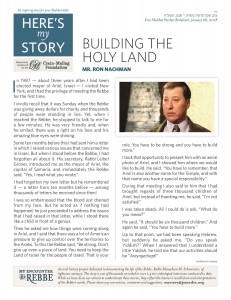Building the Holy Land
In 1987 – about three years after I had been elected mayor of Ariel, Israel – I visited New York, and I had the privilege of meeting the Rebbe for the first time.
I vividly recall that it was Sunday when the Rebbe was giving away dollars for charity and thousands of people were standing in line. Yet, when I reached the Rebbe, he stopped to talk to me for a few minutes. He was very friendly and, when he smiled, there was a light on his face and his amazing blue eyes were shining.
Some ten months before this I had sent him a letter in which I raised various issues that concerned me in Israel. But when I stood before the Rebbe, I had forgotten all about it. His secretary, Rabbi Leibel Groner, introduced me as the mayor of Ariel, the capital of Samaria, and immediately the Rebbe said, “Yes, I read what you wrote.”
I had forgotten my own letter but he remembered it – a letter from ten months before – among thousands of letters he received since then!
I was so embarrassed that the blood just drained from my face. But he acted as if nothing had happened; he just proceeded to address the issues that I had raised in that letter, while I stood there like a child in front of a genius.
Then he asked me how things were coming along in Ariel, and I said that there was a lot of American pressure to give up control over the territories to the Arabs. To this the Rebbe said, “Be strong. Don’t give up even a piece of land. You need to keep the Land of Israel for the people of Israel. That is your role. You have to be strong and you have to build more.”
I took that opportunity to present him with an aerial photo of Ariel, and I showed him where we would like to build. He said, “You have to remember, that Ariel is also another name for the Temple, and with that name you have a special responsibility.”
During that meeting I also said to him that I had brought regards of three thousand children of Ariel, but instead of thanking me, he said, “I’m not satisfied.”
I was taken aback. All I could do is ask, “What do you mean?”
He said, “It should be six thousand children.” And again he said, “You have to build more.”
Up to that point, we had been speaking Hebrew, but suddenly he asked me, “Do you speak Yiddish?” When I answered that I understand a little Yiddish, he told me that our activities should be “Arayngechapt!”
I didn’t know what he meant so Rabbi Groner chimed in to explain that arayngechapt means “catch it all.”
I still didn’t get it. “Catch what?” I asked.
“Catch every opportunity,” the Rebbe said, “Build as much as you can.”
“But who will buy the apartments?” I asked.
“Don’t worry about that,” he responded. “Just build.”
And so that’s what I did.
When I was running for re-election in 1990, I again came to see the Rebbe to ask for his blessing, which he gave me. I also asked him for advice about the best way of absorbing Russian immigrants from the Soviet Union into Ariel. I was trying to raise $5 million for this purpose, emphasizing the plight of these poor Russians. But the Rebbe said, “Be careful how you do it. Don’t say this is just to help ‘these poor Russians,’ rather, present it as something that benefits the wealthy, as well. That way, it won’t be perceived as insulting by the Soviet government, which could cause them to stop the immigration.”
As well, he discouraged me giving interviews on this particular subject. On that particular visit, I was receiving an award from Americans for a Safe Israel, and I had hoped to use that venue to launch a fund-raising campaign. The American media were waiting to interview me as the mayor of the biggest Jewish city in the West Bank, and the left-wingers were there to protest re-settling Russian Jews in Judea and Samaria. But the Rebbe said, “Don’t make too much noise,” so, while I answered reporters’ questions, I also listened to his advice and said nothing that might irritate the Soviet government.
I asked him for a blessing to build a big synagogue in Ariel – a Torah Center – where the Yemenite Jews, the Sephardic Jews and the Ashkenazi Jews could worship together under one roof. He gave me his blessing, but he said, “Keep each group separate, because each has its own tradition.”
I remained insistent on a building that would signify Jewish brotherhood, but I didn’t succeed in that endeavor, although I succeeded in many others, thanks to the Rebbe’s blessings.
Ariel started in 1978, as a settlement of forty families on a bare mountain. Today, in the year 2000, just twenty-two years later, we have four thousand families, a college with over six thousand students and an industrial park with over one hundred factories, exporting products worth half billion dollars a year.
I think I fulfilled the Rebbe’s directive to build: “Arayngechapt – catch every opportunity.”
I once said to the Rebbe, “I am not a religious person.” But he contradicted me. He said, “You are religious because you are building up Eretz Yisrael.”
The Rebbe understood that the more people that come and settle the Land, the more power and strength we will have as a nation. And that will keep Israel Jewish forever.
Mr. Ron Nachman (1942-2013) served as mayor of Ariel, Israel, for 28 years – from 1985 until his passing. He was interviewed in January of 2001.
This week’s Here’s My Story is generously sponsored:
In honor of 12 Shevat
the second Yahrzeit of our beloved uncle
Reb Chaim New
Melbourne, Australia
Dedicated by the New Family Nieces and Nephews





